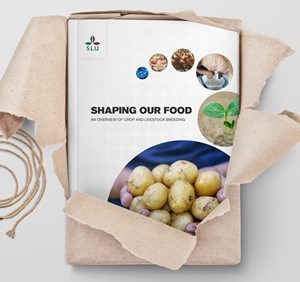Plant and livestock researchers have great use of Nobel Prize awarded genetic scissors

Several research groups at SLU work with the "genetic scissor", the gene editing tool which is awarded the Nobel Prize in Chemistry this year. A recent popular science publication from SLU describes the history of plant and animal breeding, from the beginning of agriculture more than 10,000 years ago to today's molecular work with CRISPR/Cas9.
The Royal Swedish Academy of Sciences has decided to award the Nobel Prize in Chemistry 2020 to Emmanuelle Charpentier and Jennifer A. Doudna for the discovery of one of gene technology’s sharpest tools: the CRISPR/Cas9 genetic scissor.
At SLU, many researchers work with this gene-editing tool.
“CRISPR/Cas9 has in a very short time had a huge impact in both plant research and plant breeding. It is therefore gratifying that the importance of this technology is recognized through the 2020 Nobel Prize in Chemistry”, says Dennis Eriksson, researcher at SLU's Department of Plant Breeding.
“CRISPR/Cas9 has become one of our most important tools in studies of gene function in trees – we already have lots of trees that have been changed in this way”, says Professor Ove Nilsson at Umeå Plant Science Centre, a collaboration between SLU and Umeå University. “A new automatic phenotyping platform is now used to analyse these trees”.
A research group at SLU in Alnarp in collaboration with Lyckeby Starch presented Sweden’s first ”CRISPR-Cas9 crop” – a potato developed for the starch industry – in 2016.
On the animal side, the tool has great potential for research on diseases, e.g. to understand why cancer develops. In the future, it may also be possible to develop gene therapy to cure hereditary diseases in humans and animals. When it comes to practical applications in breeding work, there are ethical issues that should be studied further.
New edition of a booklet on crop and livestock breeding methods
The recently published booklet "Shaping our food – an overview of crop and livestock breeding" presents the basics of the structures and functions of genes, describe why and how different breeding methods are applied, and give some insight into legislation surrounding the use of biotechnology in breeding in the EU and in Sweden. It also discusses ethical issues related to breeding in general and to genetic modification in particular.
The booklet is published within the research programme Mistra Biotech, which ran during the years 2012–2020 and was funded by The Swedish foundation for strategic environmental research (Mistra) and the Swedish University of Agricultural Sciences (SLU). This second edition from 2020 is a shorter, updated version of the edition published in 2014.
More information about the booklet and about Mistra Biotech
"Biotechnology for sustainability – the final report from Mistra Biotech 2012-2020" is available to read online, to download as a pdf, and can be ordered in printed format.
mistrabiotech@slu.se, +46 (0)18-67 22 32